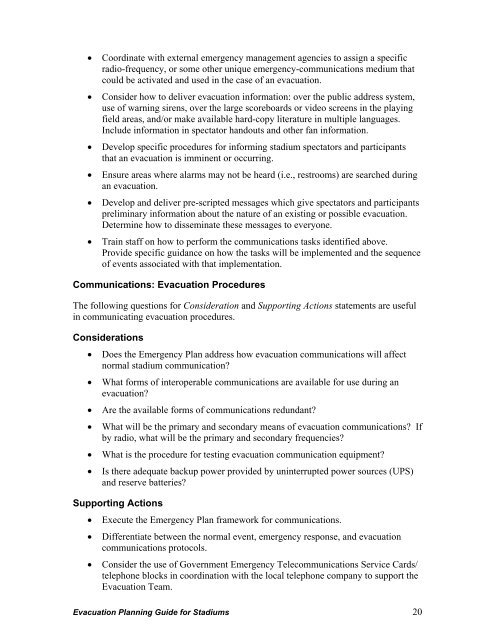Evacuation Planning Guide for Stadiums
Evacuation Planning Guide for Stadiums
Evacuation Planning Guide for Stadiums
You also want an ePaper? Increase the reach of your titles
YUMPU automatically turns print PDFs into web optimized ePapers that Google loves.
• Coordinate with external emergency management agencies to assign a specific<br />
radio-frequency, or some other unique emergency-communications medium that<br />
could be activated and used in the case of an evacuation.<br />
• Consider how to deliver evacuation in<strong>for</strong>mation: over the public address system,<br />
use of warning sirens, over the large scoreboards or video screens in the playing<br />
field areas, and/or make available hard-copy literature in multiple languages.<br />
Include in<strong>for</strong>mation in spectator handouts and other fan in<strong>for</strong>mation.<br />
• Develop specific procedures <strong>for</strong> in<strong>for</strong>ming stadium spectators and participants<br />
that an evacuation is imminent or occurring.<br />
• Ensure areas where alarms may not be heard (i.e., restrooms) are searched during<br />
an evacuation.<br />
• Develop and deliver pre-scripted messages which give spectators and participants<br />
preliminary in<strong>for</strong>mation about the nature of an existing or possible evacuation.<br />
Determine how to disseminate these messages to everyone.<br />
• Train staff on how to per<strong>for</strong>m the communications tasks identified above.<br />
Provide specific guidance on how the tasks will be implemented and the sequence<br />
of events associated with that implementation.<br />
Communications: <strong>Evacuation</strong> Procedures<br />
The following questions <strong>for</strong> Consideration and Supporting Actions statements are useful<br />
in communicating evacuation procedures.<br />
Considerations<br />
• Does the Emergency Plan address how evacuation communications will affect<br />
normal stadium communication?<br />
• What <strong>for</strong>ms of interoperable communications are available <strong>for</strong> use during an<br />
evacuation?<br />
• Are the available <strong>for</strong>ms of communications redundant?<br />
• What will be the primary and secondary means of evacuation communications? If<br />
by radio, what will be the primary and secondary frequencies?<br />
• What is the procedure <strong>for</strong> testing evacuation communication equipment?<br />
• Is there adequate backup power provided by uninterrupted power sources (UPS)<br />
and reserve batteries?<br />
Supporting Actions<br />
• Execute the Emergency Plan framework <strong>for</strong> communications.<br />
• Differentiate between the normal event, emergency response, and evacuation<br />
communications protocols.<br />
• Consider the use of Government Emergency Telecommunications Service Cards/<br />
telephone blocks in coordination with the local telephone company to support the<br />
<strong>Evacuation</strong> Team.<br />
<strong>Evacuation</strong> <strong>Planning</strong> <strong>Guide</strong> <strong>for</strong> <strong>Stadiums</strong> 20


